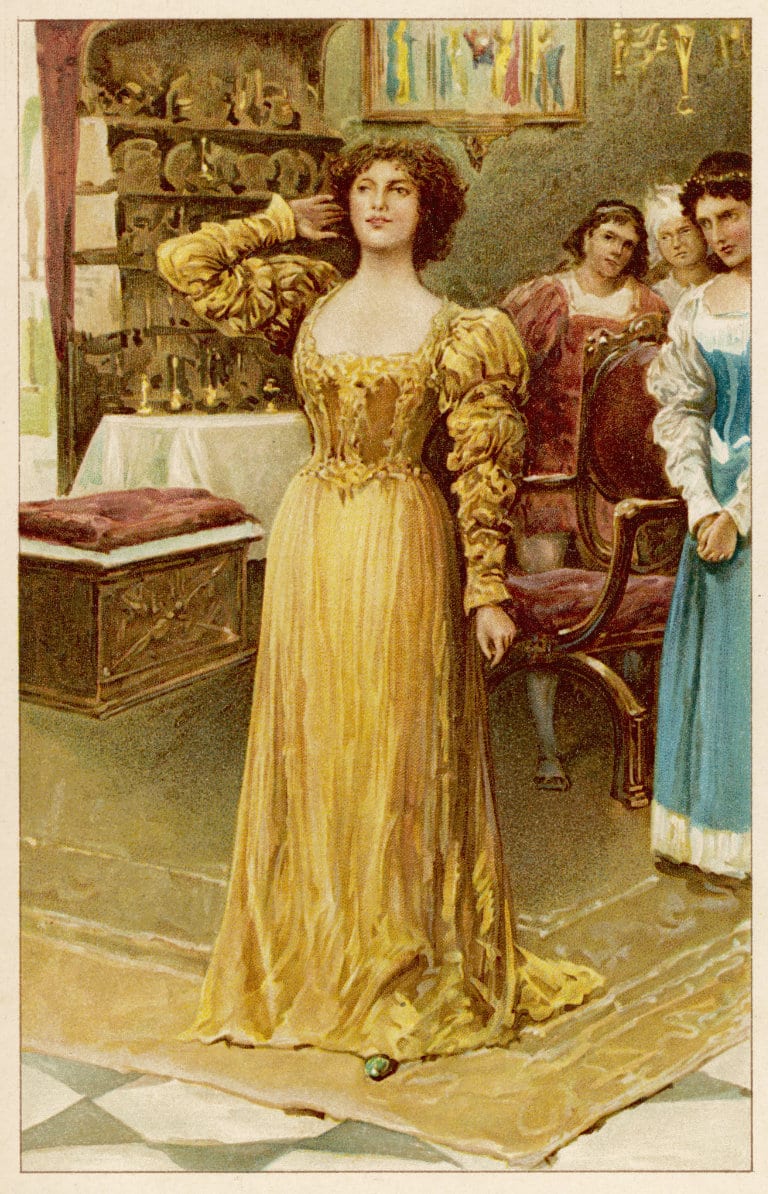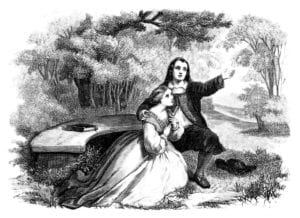It seems reasonable to think of Hamlet as an only child. Does this affect his conduct? For example, does it explain his immense loyalty to his father? Or his fractious relationship with Gertrude? It’s an intriguing question, but Hamlet is not alone: only children seem to abound in Shakespeare. Juliet is likely another such. “The earth has swallow’d all my hopes but she”, laments her father – implying that she is all he has left. Is this the key to the self-reliant, individualistic side to her character? Is this what makes her impulsive, magnetised by Romeo? Is Romeo another only child? And is it this that makes him crave for love – first Rosaline, then Juliet?
Genre is not a factor in this abundance of only children. Among Shakespeare’s Comedies, for example, Helena in “All’s Well That Ends Well” lacks not only siblings but also parents. Alone in the world, and equipped only with the medical skills she learned from her late father, she values the support given to her by the elderly Countess, but her dream is to marry the Countess’s son Bertram. Her isolation is a pressing theme of the play. Rosalind in “As You Like It” is similarly isolated, though she does at least have the support of her cousin Celia, a kind of surrogate sister. Jessica in “The Merchant of Venice” escapes from her over-protective father Shylock, but she too seems to be an only child who, like Helena and Rosalind, is mysteriously motherless.
The common ground shared by these four characters – Juliet, Helena, Rosalind and Jessica – hardly needs to be spelled out. It is shared by the heroines of Shakespeare’s late plays who are also, it seems, uncomfortably alone in the world and without siblings. Perdita in “The Winter’s Tale” did once – briefly – have a brother, but Mamillius died around the time of her birth, and she knows nothing of him or her real family. Meanwhile in “Pericles”, Marina is a doughty picture of courage, chastity and resilience, but she is as alone as any character in Shakespeare. Imogen in “Cymbeline” has an odious half-brother in Cloten, but in escaping her own family she is escaping his prurient attentions. Meanwhile, Miranda in “The Tempest” is only now learning about her background – “Thy mother”, Prospero informs her, “was a piece of virtue” – but siblings are not part of it. She too has a weakness for falling in love somewhat impetuously.
To this litany of isolated daughters might be added Desdemona in “Othello” – though she, like Jessica and Imogen, might better be described as self-isolated, and in fairness, we are not told specifically whether she has siblings. But all the signs are there: the over-protective (if not obsessive) father, the impetuous falling in love, the flight from home. Desdemona serves as a reminder that only daughters are not a feature of Comedies and Late Plays alone. Her lot in life might be contrasted with that of Ophelia, who in Laertes has a brother who gives her advice and support – perhaps too much of the former.
Shakespeare’s Histories offer further examples of the type. These tend to be males – for instance Prince Arthur in “King John”, a perfectly blameless child, who is never more alone in the world than when contemplating his escape from his uncle’s clutches. Alas, his decision to jump from the castle ramparts kills him. Prince Edward, son of Henry VI, is equally cursed in Part Three of the trilogy by his own royal blood, and his death at the hands of the future Richard III (denounced by him as “thou mis-shapen Dick”) reinforces the sense of his isolation. Less sympathetic, perhaps, is the figure of Coriolanus’s son, who delights in killing butterflies to the acclaim of his mother Virgilia and his Grandmother. But not all the only sons are so unappealing – though male only children are clearly less prominent a theme than isolated females.
It might be objected that siblings in general are thin on the ground in Shakespeare’s plays and that therefore these examples are merely a playwright’s shorthand as he winnows his material to get to what matters. So there is no time to investigate whether – say – Desdemona has brothers and sisters because the fleet is leaving for Cyprus, and time is short. Fair point. But there is no shortage of Shakespeare’s plays in which siblings play a central role. The “Henry VI” plays (along with “Richard III”) are one obvious example, because they detail the deaths of four siblings, including the murder of Clarence at the hands of his own brother. Similarly, the three daughters to whom Lear means to leave his kingdom are clearly central to the plot.
This is quite common: in “The Comedy of Errors”, a play in which brotherhood is structural to the plot, Antipholus of Syracuse arrives at Ephesus only to be repeatedly (but erroneously) mistaken for his twin brother. Keeping him company is his servant Dromio, who suffers the same fate. In other plays, brothers are contrasted with one another: in “Henry IV Part One”, for example, Prince Hal cheerfully spends his days at the tavern in Cheapside in the company of Falstaff while his younger brother Prince John engages the respect of the court and the King with his more dutiful conduct. There is less of a sense of contrast in “Titus Andronicus”, which features extraordinary cruelties, including the rape and mutilation of Lavinia at the hands of the brothers Demetrius and Chiron. Relationships between siblings are a central concern of that early play.
Elsewhere, sisters come to the rescue of siblings in distress: in “Measure for Measure” Isabella comes to the aid of her brother Claudio, after he is sentenced to death for sleeping with his fiancée before they are formally married. In the end the sentence is justly rescinded. And in “Twelfth Night” Sebastian falls on his feet following his shipwreck in Illyria, when he finds himself being romanced by the desirable Olivia, who has previously had eyes only for his twin sister Viola, disguised as Cesario. Meanwhile, in “The Taming of the Shrew”, Bianca discovers the power of her own self-assertion partly through the example of her elder sister Katherine.
Much of Shakespeare’s work focuses on family relationships. This seems logical enough when one reflects on the extent to which power – inherited or otherwise – is a central theme. Perhaps in such circumstances one cannot automatically expect siblings to seek common cause. But it is striking how often Shakespeare presents an isolated young adult – most often female – whose fortunes will turn on questions of whether or not she can cope on her own. Often, indeed – Desdemona, Jessica, Rosalind, Juliet – her isolation is self-enforced. The audience cannot help but take their part, and their lone-child status is the a key feature in our engagement with the challenges the play presents.





One Response
Fascinating!! I suspect that Shakespeare wanted to place intense focus on Juliet and Hamlet and other major characters with no siblings. In a practical sense, a sibling could be expected to give helpful advice (“Juliet, just tell mom and dad you are already married!”)…which is not what Shakespeare would have wanted. That would have probably made the tragedy less likely.